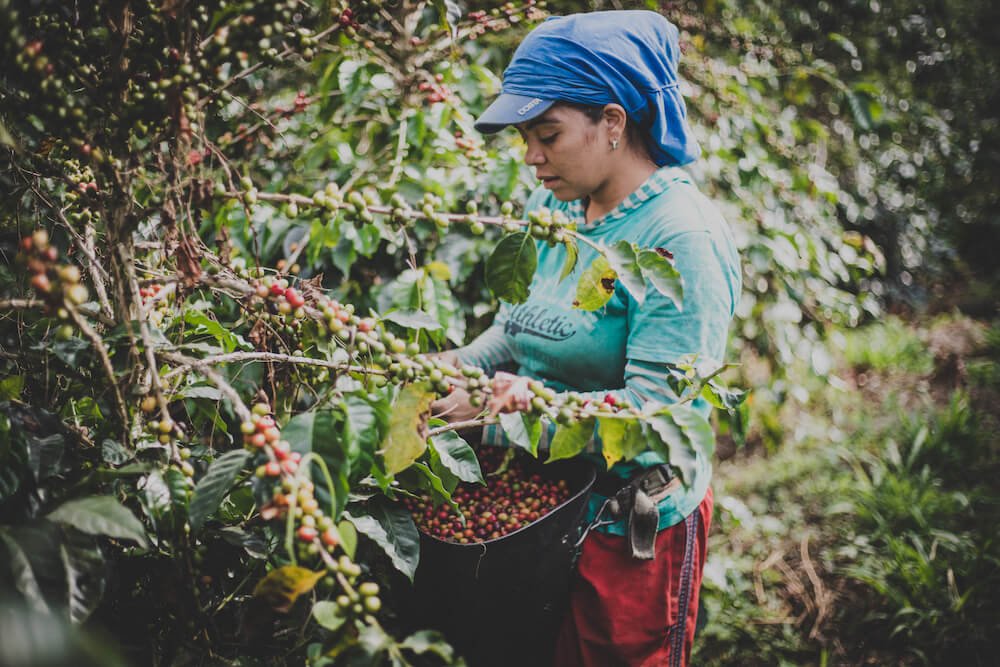Harvesting and Processing
The time between blooming and maturing of the fruit varies appreciably with the variety and the climate; for Arabica it is about seven months and for Robusta about nine months. The ripened fruits of the coffee plant are known as coffee cherries, and each cherry generally contains two coffee seeds (“beans”) positioned flat against one another. About 5 percent of cherries contain only one seed; called peaberries, those single seeds are smaller and denser and produce, in the opinion of some, a sweeter, more flavourful coffee. The fruit is gathered by hand when it is fully ripe and red-purple in colour.
The challenges of coffee cultivation
Coffee Farmers in all areas of the world face difficult challenges, when trying to produce the best possible coffee as well as keep their yields at a level where they can still make a living.
1. Changes in climate: Shifts in temperature and rainfall patterns can affect coffee growing regions, leading to altered growing conditions, increased pests and diseases, and reduction in yields. Rain at the wrong time of year as well as drought when the coffee trees need water can decimate that year's crop. As coffee is primarily a once a year crop that would leave the farmer without anything to take to market..
2. Pests and Diseases: Coffee trees are susceptible to various pests and diseases, such as coffee leaf rust and coffee berry borer, which can devastate crops if not properly managed. The changes in climate also impact the prevalence of these diseases and pests.This increases the production cost of the farmer as they now have to protect the coffee trees more than they had to before.
3. Labor Shortages: Many coffee-growing regions rely on manual labor for harvesting, but labor shortages due to migration, or changing economic conditions can impact production and increase input costs. When thinking about coffee growing regions, the farms are usually located in remote areas, so the migration of the younger population to larger metropolitan areas leaves the farmers with increased picking and processing costs due to increases in labor prices.
4. Market Volatility: Fluctuations in the coffee prices can affect the income of coffee farmers, making it challenging for them to plan and invest in their farms since they have no control over the C market price which most coffee contracts are tied to.
5. Resource Management: Sustainable water and soil management practices are crucial for coffee cultivation, but issues like water scarcity and soil degradation can pose significant challenges and an increase in production costs .
6. Quality Control: Maintaining consistent quality standards throughout the cultivation, harvesting, and processing stages is essential for coffee growers to meet consumer expectations and market demands.
7. Market Access: Small-scale coffee farmers often face barriers in accessing global markets, including lack of infrastructure, limited market information, and unfair trading practices.
Addressing these challenges requires collaboration among stakeholders, investment in research and development, adoption of sustainable practices, and support for smallholder farmers. We at Per’La do this by partnering with our farmers and ensuring that they get the support that they need.







Coffee
coffee, beverage brewed from the roasted and ground seeds of the tropical evergreen coffee plants of African origin. Coffee is one of the three most popular beverages in the world (alongside water and tea) and one of the most profitable international commodities. Though coffee is the basis for an endless array of beverages, including espresso, cappuccinos, mochas, and lattes, its popularity is mainly attributed to its invigorating effect, which is produced by caffeine, an alkaloid present in coffee.
Two species of coffee plants, Coffea arabica and C. canephora, supply almost all of the world’s consumption. Arabica is considered a milder and more flavourful and aromatic brew than Robusta, the main variety of C. canephora. The flatter and more elongated Arabica bean is more widespread than Robusta but more delicate and vulnerable to pests, requiring a cool subtropical climate; Arabica must grow at higher elevations (2,000–6,500 feet [600–2,000 metres]), it needs a lot of moisture, and it has fairly specific shade requirements. Latin America, eastern Africa, Asia, and Arabia are leading producers of Arabica coffee. The rounder, more convex Robusta bean, as its name suggests, is hardier and can grow at lower altitudes (from sea level to 2,000 feet). Robusta coffee is cheaper to produce, has twice the caffeine content of Arabica, and is typically the bean of choice for inexpensive commercial coffee brands. Western and Central Africa, Southeast Asia, and Brazil are major producers of Robusta coffee.











